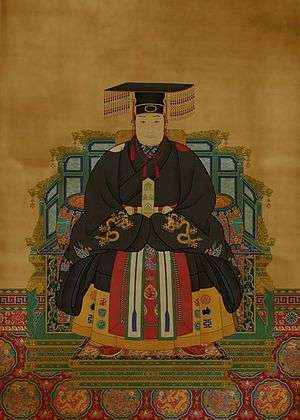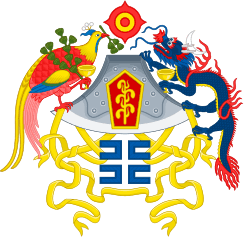Twelve Ornaments
The Twelve Ornaments (Chinese: 十二章; pinyin: Shí'èr zhāng) are a group of ancient Chinese symbols and designs that are considered highly auspicious. They were employed in the decoration of textile fabrics in ancient China, which signified authority and power, and were embroidered on vestments of state.
History
According to the Book of Documents, the Twelve Ornaments were referred to by Emperor Shun, one of the legendary Three Sovereigns and Five Emperors, as being ancient in his time. Oral tradition holds that he lived sometime between 2294 and 2184 BCE.[1] According to the book, the emperor wished for the symbols to be used on official robes of the state.
“I wish,” said the Emperor, “to see the emblematic figures of the ancients: the moon, the stars, the mountain, the dragon, and the flowery fowl, which are depicted on the upper garment; the temple-cup, the aquatic grass, the flames, the grain of rice, the hatchet, and the symbol of distinction, which are embroidered on the lower garment; I wish to see all these displayed with the five colors, so as to form the official robes; it is yours to adjust them clearly.”[2] Only the emperor had the right to wear the complete set if twelve emblems painted or embroidered on his ropes if ceremony.[3]
The twelve ornaments featured in the Twelve Symbols national emblem of China, which was the state emblem from 1913-1928.
Symbols


The portrait of the Wanli Emperor (1563–1620) in his state robes features all twelve ornaments:
On the upper Robe
- the sun (日, rì) with the three-legged crow
- the moon (月, yuè) with the moon rabbit in it, who is constantly pounding the elixir of life
- the three stars (星辰, xīngchén), which could also be the Fu Lu Shou stars, which symbolise happiness, prosperity, and longevity
- the sacred mountains (山, shān), which symbolize stability and tranquility
- the dragon (龍, lóng), symbol of adaptability and strength
- the pheasant (華蟲), which is however the phoenix (鳳凰, fenghuang), symbol of peace and refinement
The dragon and phoenix represent the natural world. In yin and yang terminology, a dragon is male yang and the phoenix a female yin. Therefore, the emperor was often identified as the dragon, while the empress was the phoenix. This was also reflected in the robes they wore.
On the lower robe
- two cups (宗彝, zōng yí), which are a sacrificial utensil, sometimes feature patterns containing each a tiger and a monkey, and symbolize faithfulness and respect
- a spray of pondweed or algae (藻, zǎo), a symbol of brightness and purity
- fire (火, huǒ), which symbolises brightness.
- grains of rice (粉米, fěn mǐ), which symbolise nourishment and the country's agriculture, but also wealth
- an axe (黼, fǔ), symbol of courage and resolution, but also executive justice.
- The figure 亞 (黻, fú) underneath the axe represents two animals with their backside together. This symbolises the capability to make a clear distinction between right and wrong.
See also
- Ashtamangala, the eight Buddhist treasures
- Bagua, the eight Taoist symbols
References
- ↑ C.A.S, Williams (September 2001). Chinese Symbolism and Art Motifs (4th ed.). Tuttle Publishing. p. 386. ISBN 0-8048-3704-X.
- ↑ James Legge, "Sacred Books of the East/Volume 3/The Shu/Part 2/Yi and Ki", Wikisource.
- ↑ C.A.S, Williams (September 2001). Chinese Symbolism and Art Motifs (4th ed.). Tuttle Publishing. p. 387. ISBN 0-8048-3704-X.
External links
- The twelve symbols of sovereignty in Powerhouse Museum
- http://www.nationsonline.org/oneworld/Chinese_Customs/symbols_of_sovereignty.htm